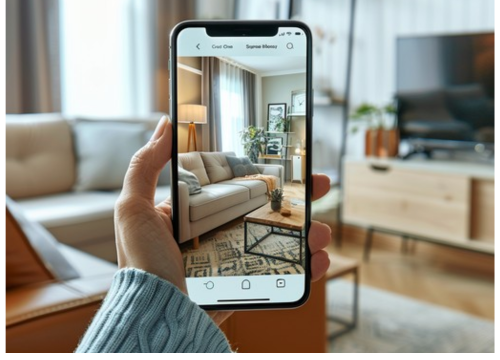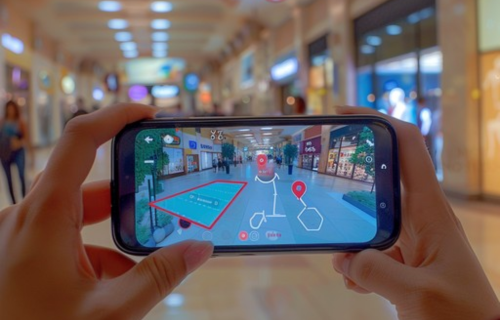IKEA Immersive Mobile Marketing with VR and AR: Redefining Furniture Shopping for an Unforgettable Experience

The integration of IKEA Immersive Mobile Marketing with VR and AR has redefined the shopping experience in the retail industry, particularly for furniture shopping. Through the IKEA Place app, customers can visualize how a piece of furniture will look in their homes before purchasing it. This innovative approach addresses key challenges that IKEA faced in online furniture shopping while improving the customer experience by leveraging Augmented Reality (AR). This article explores how the IKEA Place app works, its impact on IKEA’s sales, the technological investments needed, ethical considerations, and valuable lessons other retailers can learn from IKEA’s success.
Table of Contents
1. Introduction
As technology continues to evolve, companies like IKEA have embraced IKEA Immersive Mobile Marketing with VR and AR to transform how customers shop. The IKEA Place app, launched in 2017, uses AR to let customers visualize furniture in their real-world environment, which solves a long-standing issue in online shopping—uncertainty about how products will fit or look in a home. With over 430 stores worldwide and an annual revenue of $42 billion (2021)(IKEA-Service-innovation…)(IKEA Use cases), IKEA’s ability to combine innovative technology with practical shopping needs has proven to be a game-changer for the company and the entire retail industry.
2. Challenges IKEA Faced Before AR
Before implementing AR, IKEA’s customers encountered several challenges when shopping online for furniture. The most common issues were:
- Uncertainty of Fit: Customers were unsure whether furniture would fit in their living space.
- Mismatch in Appearance: Online images often didn’t accurately represent how furniture would look in specific lighting or next to other items.
- High Return Rates: Due to these uncertainties, IKEA faced a significant volume of product returns, which increased operational costs and reduced customer satisfaction.
These challenges prompted IKEA to explore immersive solutions like AR, which could provide customers with a more accurate, engaging shopping experience.
3. How the IKEA Place App Works
The IKEA Place app allows users to browse through IKEA’s product catalog and place virtual furniture items in their homes using their smartphone camera. By utilizing AR technology, the app superimposes 3D models of furniture into the real world, enabling users to see the size, style, and fit of furniture in their own spaces.
- Easy Navigation: Customers can select items from different categories, such as living room or bedroom furniture, and virtually place them in their homes(IKEA Use cases).
- Interactive Features: Users can rotate and view the furniture from multiple angles to get a comprehensive idea of how it will look in their space.
- Accurate Sizing and Texture: With a 98% accuracy rate for size, texture, and lighting(IKEA Use cases), the app provides a realistic representation of how items will appear in the customer’s home environment.
The app’s seamless integration with IKEA’s e-commerce platform allows users to save their favorite items, share images with friends, and complete their purchase directly through the app.
4. Technological Investments and Prerequisites
he development of IKEA Immersive Mobile Marketing with VR and AR required significant technological investments. IKEA partnered with Apple’s ARKit to create the IKEA Place app, which utilizes the iPhone’s motion sensors and camera to blend virtual furniture with real-world settings(IKEA-Service-innovation…).
Some of the key prerequisites for implementing this AR solution included:
- High-Quality 3D Modeling: IKEA had to develop detailed 3D models of over 2,000 furniture items, ensuring that they were accurately represented in terms of size, color, and texture(IKEA Use cases).
- Device Compatibility: Initially launched for iOS, the app later expanded to support Android, which increased its accessibility.
- App Integration: The IKEA Place app had to be seamlessly integrated with IKEA’s existing mobile infrastructure to provide a smooth user experience.
The technological foundation for this immersive marketing strategy involved collaborating with top developers and ensuring the app’s performance met IKEA’s high standards for user experience.
5. Impact of IKEA Place on Sales and Returns
The IKEA Place app has had a significant positive impact on both IKEA’s sales and return rates. Here are some key results:
- Increased Sales: After launching the app, IKEA saw a substantial boost in online sales, with some estimates suggesting a 35% increase(IKEA-Service-innovation…). The ability to “try before you buy” using AR gave customers the confidence to make more informed purchases.
- Reduced Returns: By helping customers visualize furniture in their home environment, the app significantly reduced product return rates, which previously posed a major logistical challenge for IKEA(IKEA-Service-innovation…).
- Enhanced Customer Engagement: The interactive nature of AR kept users engaged longer, leading to higher conversion rates and customer loyalty.

6. Ethical Considerations in AR Use
While IKEA Immersive Mobile Marketing with VR and AR offers numerous benefits, there are ethical considerations, particularly around data privacy. The app requires access to a user’s camera and possibly location data, raising concerns about how IKEA collects and uses this information.
IKEA has addressed these concerns by ensuring users have control over their data. The app does not store images or videos without the user’s consent, and IKEA adheres to strict data privacy regulations like GDPR(IKEA Use cases).
7. Lessons for Other Retailers
The success of IKEA Immersive Mobile Marketing with VR and AR offers valuable lessons for other retailers considering similar technology:
- Prioritize User Experience: IKEA’s app emphasizes ease of use, clear navigation, and accuracy, all of which are essential for user adoption and satisfaction.
- Test Before Full Rollout: Companies can benefit from piloting AR solutions in select markets to refine the user experience before launching globally.
- Combine Technology with Practical Value: AR should not be used for novelty’s sake but to solve real customer challenges, as IKEA did by addressing the uncertainty of online furniture shopping.
- Ethical Data Practices: Transparency and consent around data usage are critical in building customer trust.
8. Conclusion
IKEA Immersive Mobile Marketing with VR and AR through the IKEA Place app has revolutionized how customers shop for furniture. By allowing users to visualize products in their own homes, IKEA has not only increased sales and reduced returns but also set a new standard for customer engagement in the retail industry. As other retailers consider adopting similar technologies, the lessons from IKEA’s AR success provide a blueprint for creating immersive, effective, and ethical marketing strategies that resonate with modern consumers.








2 Comments
Comments are closed.